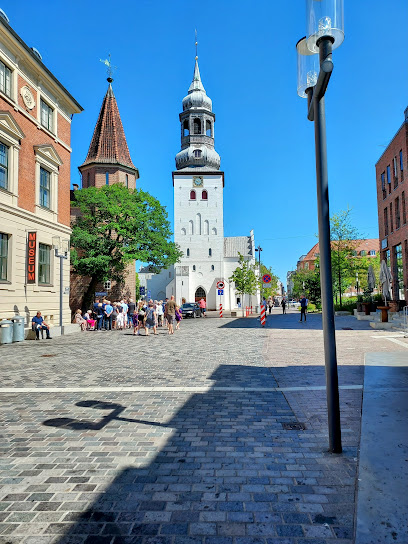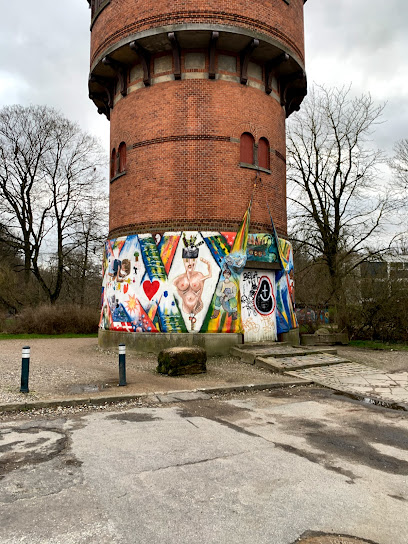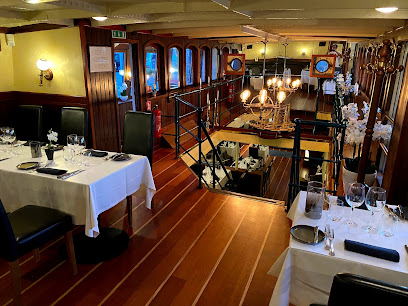
Aalborg: Denmark's Northern Gem
Discover Aalborg, Denmark's northern gem, where medieval charm meets modern vibrancy. Enjoy rich history, cultural landmarks, and a lively culinary scene.
Aalborg, located in the northern part of Denmark, is a city that combines the charm of old-world architecture with the vibrancy of modern life. Known for its rich history and cultural landmarks, Aalborg offers visitors a unique blend of old and new. As you stroll through the streets, you'll encounter a mix of medieval buildings, picturesque streets, and contemporary art installations that tell the story of this dynamic city. The waterfront area, known as the Aalborg Harbour, is a must-visit. Here, you can enjoy a leisurely walk along the Limfjord, dine in one of the many waterfront restaurants, or take a boat tour to see the city from a different perspective. The Utzon Center, designed by the famous architect Jørn Utzon, is a highlight of the harbour area and offers exhibitions that are both engaging and informative. Aalborg is also home to several notable museums and historic sites. The Aalborg Historical Museum provides an in-depth look at the city's past, while the Aalborg Tower offers panoramic views of the surrounding area. For those interested in Viking history, the Lindholm Høje burial site is a fascinating place to explore. Art enthusiasts will enjoy the Kunsten Museum of Modern Art, which features works by Danish and international artists. In addition to its cultural attractions, Aalborg is known for its lively nightlife and culinary scene. The city's main street, Jomfru Ane Gade, is lined with bars, clubs, and restaurants, making it a popular spot for both locals and tourists. Whether you're looking for traditional Danish cuisine or international flavors, you'll find plenty of options to satisfy your taste buds in Aalborg.
Local tips in Aalborg
- Visit the Aalborg Tower for stunning panoramic views of the city and surrounding areas.
- Explore Jomfru Ane Gade for a lively nightlife experience with bars and restaurants.
- Take a boat tour along the Limfjord to see Aalborg from a unique perspective.
- Don't miss the Lindholm Høje burial site for a fascinating glimpse into Viking history.
- Check the schedule at the Utzon Center for special exhibitions and events.
Aalborg: Denmark's Northern Gem
Aalborg, located in the northern part of Denmark, is a city that combines the charm of old-world architecture with the vibrancy of modern life. Known for its rich history and cultural landmarks, Aalborg offers visitors a unique blend of old and new. As you stroll through the streets, you'll encounter a mix of medieval buildings, picturesque streets, and contemporary art installations that tell the story of this dynamic city. The waterfront area, known as the Aalborg Harbour, is a must-visit. Here, you can enjoy a leisurely walk along the Limfjord, dine in one of the many waterfront restaurants, or take a boat tour to see the city from a different perspective. The Utzon Center, designed by the famous architect Jørn Utzon, is a highlight of the harbour area and offers exhibitions that are both engaging and informative. Aalborg is also home to several notable museums and historic sites. The Aalborg Historical Museum provides an in-depth look at the city's past, while the Aalborg Tower offers panoramic views of the surrounding area. For those interested in Viking history, the Lindholm Høje burial site is a fascinating place to explore. Art enthusiasts will enjoy the Kunsten Museum of Modern Art, which features works by Danish and international artists. In addition to its cultural attractions, Aalborg is known for its lively nightlife and culinary scene. The city's main street, Jomfru Ane Gade, is lined with bars, clubs, and restaurants, making it a popular spot for both locals and tourists. Whether you're looking for traditional Danish cuisine or international flavors, you'll find plenty of options to satisfy your taste buds in Aalborg.
When is the best time to go to Aalborg?
Iconic landmarks you can’t miss
Aalborg Zoo
Explore Malmö’s premier museum for technology, science, and seafaring, featuring interactive exhibitions, classic vehicles, and Sweden’s only public submarine display.

House of Music
Discover Malmö's immersive museum of science, technology, and maritime history—featuring a real submarine, interactive displays, and family-friendly innovation.

Vikingemuseet Lindholm Høje
Striking concert hall in Copenhagen’s Ørestad district, renowned for its cutting-edge architecture, world-class acoustics, and home to the Danish National Symphony Orchestra.

Kunsten Museum of Modern Art Aalborg
Experience hands-on science, vintage vehicles, and maritime history in one of Sweden’s most engaging museums, set within Malmö’s castle grounds.

Østre Anlæg
Explore Malmö’s celebrated hub for technology, science, and maritime heritage—offering hands-on discoveries and a genuine submarine, just steps from Malmöhus Castle.

Aalborgtårnet
Jægersborggade: Copenhagen’s creative corridor in Nørrebro, renowned for artisan shops, acclaimed bakeries, indie boutiques, and a vibrant local atmosphere.

Aalborghus Castle
Discover Copenhagen’s hipster haven on Jægersborggade: a vibrant, creative street filled with cozy cafés, local boutiques, and authentic Scandinavian flair in Nørrebro.

Aalborg Historical Museum
Jægersborggade in Nørrebro is Copenhagen’s trendsetting street, famed for its artisan shops, innovative cafés, organic bakeries, and unique local atmosphere.

Aalborg Station
A visionary concert hall in Copenhagen, DR Koncerthuset offers breathtaking architecture and acclaimed acoustics for unforgettable music experiences.

Aalborg Kloster
Discover Aalborg Kloster, a remarkably preserved 15th-century monastery in central Aalborg, where medieval history, tranquil gardens, and living tradition meet.

Lindholm Høje
Striking Jean Nouvel-designed concert hall, home to the Danish National Symphony Orchestra and a hub for world-class music and unique architecture in Copenhagen.

De Syngende Træer (Park of Music)
A dynamic museum blending Sweden’s technological innovation with maritime adventure, featuring historic exhibits, a real submarine, and hands-on experiences for all ages.

Gråbrødrekloster Museum
A bustling Nørrebro hotspot famous for independent boutiques, artisan makers, and acclaimed culinary experiences—Copenhagen’s Bohemian street at its best.

Old City Hall
Copenhagen’s architectural wonder—the DR Koncerthuset—offers world-class concerts, innovative design by Jean Nouvel, and unforgettable acoustics in dynamic Ørestad.

Jens Bangs Stonehouse
Discover Malmö’s gateway to science, technology, and maritime adventure, where hands-on exhibits and real submarines bring Swedish innovation to life.

Essential places to dine
Restaurant Flammen - Aalborg
Social barbecue and buffet dining in a characterful central warehouse, offering a wide variety of grilled meats and sides in the heart of Aalborg’s city centre.

Restaurant Grillen Burgerbar Aalborg
Experience gourmet burgers by the waterfront at Grillen Burgerbar Aalborg - where flavor meets fun!

Café Peace
Modern café and brasserie in central Aalborg, blending Nordic and international flavours, with a lively terrace and all-day dining from morning coffee to evening cocktails.

Caféministeriet
Caféministeriet is Aalborg’s stylish center for brunch, smørrebrød, and brasserie-style dining, attracting locals and travelers with its vibrant city-center atmosphere.

Restaurant MEAT
Central Aalborg's destination for steak lovers, offering premium grilled meats, a lively ambiance, and Danish hospitality in a chic, urban setting.

Den Bette Kro
Historic Danish restaurant in central Aalborg serving classic smørrebrød and traditional fare with live music, local brews, and an inviting, authentic atmosphere.

Pingvin
Discover the exquisite flavors of Aalborg at Pingvin, where authentic tapas meet modern dining in a vibrant setting.

Restaurantskibet Prinses Juliana
Historic Dutch ship turned fine dining hotspot on Aalborg’s Limfjord, offering elegant cuisine, panoramic waterside views, and a maritime atmosphere unlike any other in Denmark.

Søgaards Bryghus
Renowned brewpub in Aalborg Centrum offering house-made craft beers, modern Danish cuisine, and a lively atmosphere in a landmark former apothecary building.

Hos Henius
Discover the essence of Danish cuisine at Hos Henius in Aalborg - where tradition meets taste in a cozy setting.

OmBord - Restaurant Aalborg
Discover the culinary delights of Denmark at OmBord in Aalborg - where fresh local ingredients meet stunning waterfront views.

Bistro V
Discover Bistro V in Aalborg - where contemporary cuisine meets local flavors in a cozy bistro setting.

Mortens Kro Restaurant & Boutique hotel
Experience modern Nordic cuisine and luxury accommodations at Aalborg's premier dining destination.

Duus Vinkjælder
Atmospheric vaulted cellar tavern in central Aalborg offering classic Danish fare, local wines, and centuries-old ambiance beneath a historic merchant house.

Restaurant SMAEK
Experience exquisite Danish cuisine at Restaurant SMAEK in Aalborg, where fresh local ingredients meet stunning waterfront views.

Markets, malls and hidden boutiques
Aalborg Storcenter
Aalborg Storcenter: An expansive modern shopping center blending Danish favorites, global retailers, food courts, and family-friendly amenities in Aalborg SV.

Salling Department Store
Iconic Danish department store at Nytorv, Aalborg—offering shopping, gourmet flavors, and stunning rooftop views in the city’s vibrant pedestrian heart.

Monki
Discover Monki's unique fashion blend of Scandinavian minimalism and Tokyo street style in Aalborg's Friis Shopping Center.

TheNewNew
Discover Aalborg's trendsetting boutique, TheNewNew, offering exclusive contemporary fashion and lifestyle products in a chic, minimalist setting.

Fabiosvine
Discover contemporary Scandinavian fashion at Fabiosvine, Aalborg's premier boutique on Bispensgade.

Local Phrases
-
- HelloHej
[hey] - GoodbyeFarvel
[far-vel] - YesJa
[ya] - NoNej
[nay] - Please/You're welcomeVær så god
[vaer so go] - Thank youTak
[tahk] - Excuse me/SorryUndskyld
[oon-skul] - How are you?Hvordan har du det?
[vor-dan har doo deh] - Fine. And you?Fint. Og du?
[fint oh doo] - Do you speak English?Taler du engelsk?
[tah-ler doo eng-elsk] - I don't understandJeg forstår ikke
[yai for-stor ih-keh]
- HelloHej
-
- I'd like to see the menu, pleaseJeg vil gerne se menuen, tak
[yai vil geh-neh seh meh-noo-en tahk] - I don't eat meatJeg spiser ikke kød
[yai spee-ser ih-keh kuhd] - Cheers!Skål!
[skowl] - I would like to pay, pleaseJeg vil gerne betale, tak
[yai vil geh-neh beh-tah-leh tahk]
- I'd like to see the menu, pleaseJeg vil gerne se menuen, tak
-
- Help!Hjælp!
[hyelp] - Go away!Gå væk!
[goh væk] - Call the Police!Ring til politiet!
[ring teel poh-lee-tee-et] - Call a doctor!Ring efter en læge!
[ring af-ter en lay-eh] - I'm lostJeg er faret vild
[yai air fah-ret veel] - I'm illJeg er syg
[yai air soog]
- Help!Hjælp!
-
- I'd like to buy...Jeg vil gerne købe...
[yai vil geh-neh kuh-buh] - I'm just lookingJeg kigger bare
[yai kee-geh beh-reh] - How much is it?Hvor meget koster det?
[vor mayt kohs-ter deh] - That's too expensiveDet er for dyrt
[deh air for doo-ert] - Can you lower the price?Kan du sænke prisen?
[kan doo saeng-keh pree-sen]
- I'd like to buy...Jeg vil gerne købe...
-
- What time is it?Hvad er klokken?
[vah air kloh-ken] - It's one o'clockKlokken er et
[kloh-ken air et] - Half past (10)Halv ti
[halv tee] - MorningMorgen
[moh-ren] - AfternoonEftermiddag
[ef-ter-mee-dah] - EveningAften
[af-ten] - YesterdayI går
[ee goh] - TodayI dag
[ee dah] - TomorrowI morgen
[ee moh-ren] - 1En
[en] - 2To
[toh] - 3Tre
[treh] - 4Fire
[fee-reh] - 5Fem
[fem] - 6Seks
[seks] - 7Syv
[siv] - 8Otte
[oh-teh] - 9Ni
[nee] - 10Ti
[tee]
- What time is it?Hvad er klokken?
-
- Where's a/the...?Hvor er en/et...?
[vor air en/et] - What's the address?Hvad er adressen?
[vah air ah-dres-sen] - Can you show me (on the map)?Kan du vise mig (på kortet)?
[kan doo vee-seh meeh (poh kohr-teh)] - When's the next (bus)?Hvornår er næste (bus)?
[vor-nohr air nes-teh (boos)] - A ticket (to ....)En billet (til ....)
[en bi-let (teel)]
- Where's a/the...?Hvor er en/et...?
History of Aalborg
-
Aalborg's history dates back over a thousand years to the Viking Age. Archaeological findings, such as the Lindholm Høje burial site, reveal that this area was a significant Viking settlement. The site includes well-preserved stone ships and grave goods, offering a glimpse into the lives and deaths of the Vikings who once inhabited the region.
-
By the Middle Ages, Aalborg had grown into a bustling market town. Its strategic location by the Limfjord made it an important hub for trade and commerce. In 1342, Aalborg was granted town privileges by King Valdemar IV, which further boosted its economic significance. The construction of the impressive Budolfi Cathedral in the late 14th century is a testament to the town's growing prominence.
-
The Renaissance period saw the construction of Aalborghus Castle in the mid-16th century. Commissioned by King Christian III, the castle served as both a fortress and a residence for the king's officials. Today, the castle is a key historical landmark, providing insights into the architectural styles and political dynamics of the era.
-
In the 19th century, Aalborg underwent a significant transformation due to the Industrial Revolution. The establishment of industries like cement production, tobacco manufacturing, and shipbuilding turned Aalborg into one of Denmark's leading industrial centers. The Aalborg Portland cement factory, founded in 1889, remains one of the largest cement producers in the world.
-
During World War II, Aalborg was occupied by German forces. The city's strategic location and airfield made it a key target for the Nazis. The occupation had a profound impact on the local population, leading to resistance efforts and significant hardships. The Aalborg Air Base, originally constructed by the Germans, remains an important military site today.
-
In recent decades, Aalborg has transformed from an industrial powerhouse to a vibrant cultural and educational center. The establishment of Aalborg University in 1974 has contributed significantly to the city's intellectual and cultural growth. Modern Aalborg is known for its rich cultural scene, including festivals like the Aalborg Carnival and the Aalborg Opera Festival, which draw visitors from around the world.
Aalborg Essentials
-
Aalborg is well-connected by air, rail, and road. Aalborg Airport (AAL) offers both domestic and international flights and is located just 6 kilometers northwest of the city center. From the airport, you can take a taxi, bus, or rent a car to reach the city. Aalborg is also accessible by train, with frequent connections to Copenhagen, Aarhus, and other major Danish cities. If you're driving, the E45 highway provides a direct route to Aalborg from various parts of Denmark and neighboring countries.
-
Aalborg boasts a well-organized public transportation system, including buses and trains operated by Nordjyllands Trafikselskab (NT). The city center is compact and walkable, making it easy to explore on foot. For longer distances, consider renting a bicycle, as Aalborg is bike-friendly with numerous cycling paths. Taxis are also readily available. If you plan to explore the surrounding areas, renting a car can be a convenient option.
-
The official currency in Denmark is the Danish Krone (DKK). Credit and debit cards are widely accepted in Aalborg, including in most hotels, restaurants, and shops. Mobile payment options such as MobilePay are also popular. ATMs are plentiful throughout the city, making it easy to withdraw cash if needed. It's advisable to carry some cash for smaller establishments and public transport.
-
Aalborg is generally a safe city for tourists. However, like any urban area, it's important to stay vigilant. Avoid poorly lit areas at night and keep an eye on your belongings in crowded places. The city center and popular tourist spots are usually safe, but exercise caution in less frequented areas. Aalborg does not have specific high-crime neighborhoods, but it's always wise to stay aware of your surroundings.
-
In case of emergency, dial 112 for immediate assistance. This number connects you to police, fire, and medical services. Aalborg University Hospital is the main medical facility and provides comprehensive care. Pharmacies are available for minor health issues, and many are open 24/7. It's advisable to have travel insurance that covers medical emergencies.
-
Fashion: Do dress smart-casual, especially when dining out. Avoid overly casual attire in upscale restaurants. Religion: Do respect religious sites by dressing modestly and behaving respectfully. Public Transport: Do have a valid ticket before boarding and give up your seat to elderly passengers. Don't eat or drink on public transport. Greetings: Do greet people with a firm handshake and maintain eye contact. Eating & Drinking: Do try local dishes and follow dining etiquette. Don't leave food on your plate, as it is considered wasteful.
-
To experience Aalborg like a local, visit the city's bustling markets such as the Fjordbyen and the New Market in Gammeltorv for fresh produce and local delicacies. Take a stroll along the waterfront at the Limfjord and enjoy a coffee at one of the many cafes. Engage with locals, who are generally friendly and willing to share stories about the city's history and culture. Don’t miss the Aalborg Carnival if you're visiting in late May—it’s the largest carnival in Northern Europe.
Trending Landmark in Aalborg
-
Aalborg Zoo
-
House of Music
-
Vikingemuseet Lindholm Høje
-
Kunsten Museum of Modern Art Aalborg
-
Østre Anlæg
-
Aalborgtårnet
-
Aalborghus Castle
-
Aalborg Historical Museum
-
Aalborg Station
-
Aalborg Kloster
-
Lindholm Høje
-
De Syngende Træer (Park of Music)
-
Gråbrødrekloster Museum
-
Old City Hall
-
Jens Bangs Stonehouse
Nearby Cities to Aalborg
-
Things To Do in Frederikshavn
-
Things To Do in Randers
-
Things To Do in Viborg
-
Things To Do in Skagen
-
Things To Do in Silkeborg
-
Things To Do in Aarhus
-
Things To Do in Herning
-
Things To Do in Horsens
-
Things To Do in Gothenburg
-
Things To Do in Vejle
-
Things To Do in Kalundborg
-
Things To Do in Kristiansand
-
Things To Do in Kolding
-
Things To Do in Odense
-
Things To Do in Hillerød













